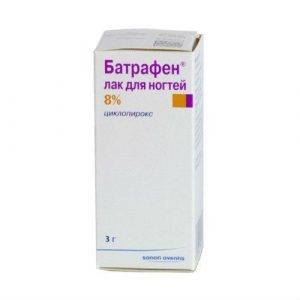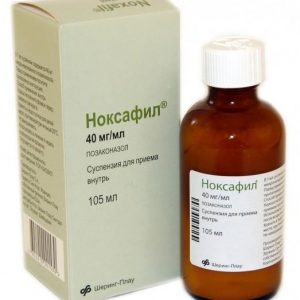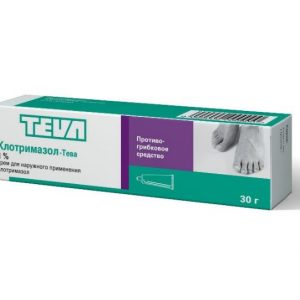Description
Release form
Ointment.
Pharmacological action
Ketoconazole-Acre – an antifungal agent. It has fungicidal and fungistatic effects. The mechanism of action is to inhibit the synthesis of ergosterol and change the lipid composition of the membrane. It is active against the causative agent of multi-colored lichen Malassezia furfur, the causative agents of certain dermatomycoses (Trichophyton, Epidermophyton floccosum, Microsporum), the causative agents of candidiasis (Candida), as well as the causative agents of systemic mycoses (Cryptococcus).
Also active against gram-positive cocci: Staphylococcus spp., Streptococcus spp.
Pharmacokinetics
Ketoconazole is a weak dibasic compound, which dissolves and is absorbed in an acidic environment. Cmax of ketoconazole in plasma is about 3.5 μg / ml and is achieved 1-2 hours after a single oral dose of 200 mg with meals. The bioavailability of ketoconazole is maximal when taken with food. Ketoconazole absorption is reduced in patients with reduced acidity of gastric juice, for example, taking antacids such as aluminum hydroxide, and antisecretory drugs such as histamine H2 receptor blockers and proton pump inhibitors, as well as in patients with achlorhydria, caused by terminal illness.
Binding to plasma proteins, mainly to the albumin fraction, is 99%. Ketoconazole is widely distributed in the tissues, but only a small part of the drug penetrates into the cerebrospinal fluid.
After absorption from the digestive tract, ketoconazole is metabolized in the liver to form a large number of inactive metabolites.
In vitro studies have shown that the isoenzyme CYP3A4 is involved in the metabolism of ketoconazole. The main metabolic pathways are the oxidation and cleavage of the imidazole and piperazine rings, oxidative O-dealkylation and aromatic hydroxylation. Ketoconazole is not an inducer of its own metabolism. Excretion from plasma is two-phase: during the first 10 hours, T1 / 2 is 2 hours, in the subsequent 8 hours.
About 13% is excreted in the urine, of which 2-4% is unchanged. It is excreted mainly with bile in the digestive tract and about 57% is excreted with feces.
Indications
– Fungal skin diseases, mycoses of skin folds, feet
– pityriasis versicolor, erythrasma, superficial candidiasis caused by dermatophytes, yeast (including the genus Candida), mold and other fungi and pathogens sensitive to clotrimazole – pyoderma.
Contraindications
Hypersensitivity to clotrimazole, I trimester of pregnancy.
Special instructions
Simultaneous treatment of sexual partners is necessary to prevent the spread of urogenital infection. In case of trichomoniasis, for the more successful treatment together with clotrimazole, other drugs with a systemic effect (for example, metronidazole inside) should be prescribed.
Vaginal tablets are not recommended for use during menstruation.
In the case of an unintended use of the drug (oral), the following symptoms are possible – anorexia, nausea, vomiting, gastralgia, impaired liver function, rarely drowsiness, hallucinations, pollakiuria, skin allergic reactions. In these situations, it is necessary to take activated charcoal and consult a doctor.
If allergic reactions or irritation develop, treatment should be discontinued and other therapy selected. With dermatomycosis of the feet, the use of a solution after each washing of the feet is recommended.
The application of the drug to the skin in the eye area is not recommended.
If, after 4 weeks from the start of treatment, no clinical improvement is noted, it is necessary to confirm the diagnosis microbiologically and exclude another cause of the disease.
Composition of
100 g of ointment contain:
Active ingredient:
clotrimazole 1.0 g
Excipients:
castor oil,
methyl cellulose water-soluble,
monoglycerides, distilled, srdlklplcklrdlrdlrd, srdlklarglprdprd, srdlklplrdlrdlrd, srdlklplrdlrdlrd sodium benzoate,
purified water.
Dosage and administration
For external use, apply to affected skin 2-3 times a day for 2-4 weeks.
When treating the oral cavity, apply 1-2 times a day for no more than 7 days.
Intravaginally – 100-500 mg for 1-6 days.
Side effects
Local reactions: contact allergic dermatitis, redness, burning sensation.
Drug interaction
Reduces the effect of polyene antibiotics (amphotericin, nystatin, natamycin, etc.). Propyl ester of para-hydroxybenzoic acid in high concentrations enhances the antifungal effect of clotrimazole, dexamethasone reduces. With simultaneous use with nystatin, the activity of clotrimazole may decrease.
Storage conditions
In the dark place at a temperature below 25 ° C.
Expiration
3 years.
Deystvuyuschee substances
Clotrimazolum
Dispensing conditions at the
pharmacies Over-the-counter
Dosage form
ointment
Akrikhin HFC AO, Russia




